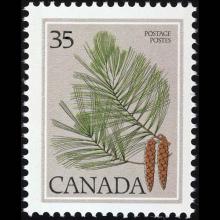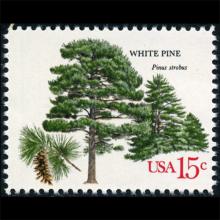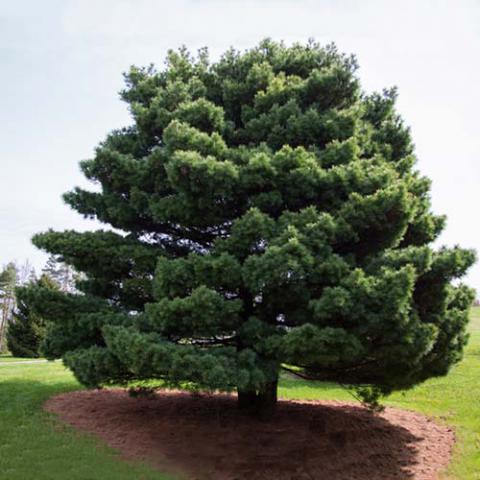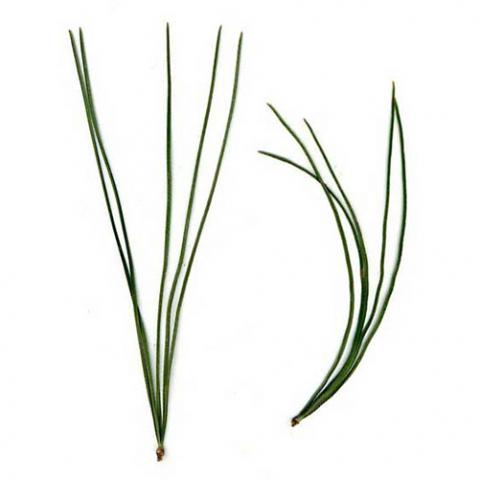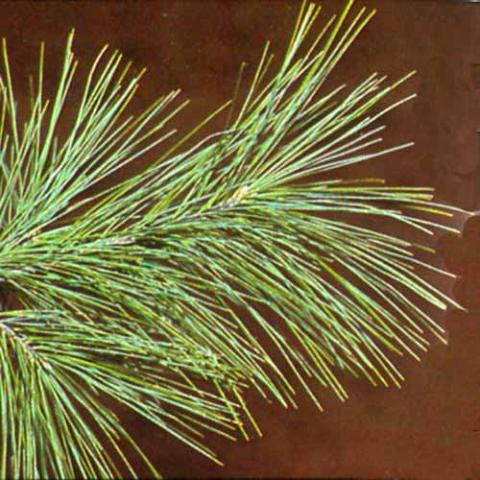NAME(S)
TAXONOMY
PLANTAE ID
THERAPEUTIC
Canada
Issued:
Stamp:
Pinus strobus
United States
Issued:
Stamp:
Pinus strobus
Canada
Issued:
Stamp:
Pinus strobus
United States
Issued:
Stamp:
Pinus strobus
Canada
Issued:
Stamp:
Pinus strobus
United States
Issued:
Stamp:
Pinus strobus
Genus species (Plantae): Pinus strobus
Pinus strobus, the largest northeastern conifer, a magnificent evergreen tree with straight trunk and crown of horizontal branches, 1 row added a year, becoming broad and irregular., native to eastern North America. It occurs from Newfoundland west through the Great Lakes region to southeastern Manitoba and Minnesota, and south along the Appalachian Mountains and upper Piedmont to northernmost Georgia and perhaps very rarely in some of the higher elevations in northeastern Alabama, and is planted in areas near its natural range where summer temperatures are fairly moderate. This tree is known to the Native American Haudenosaunee (Iroquois nation) as the Tree of Peace. It is known as the Weymouth pine in the United Kingdom, after George Weymouth who brought it to England in 1620.
Distribution
Pinus strobus is found in the Nearctic Temperate broadleaf and mixed forests Biome of eastern North America. It prefers well-drained soil and cool, humid climates, but can also grow in boggy areas and rocky highlands. In mixed forests, this dominant tree towers over all others, including the large broadleaf hardwoods. It provides food and shelter for numerous forest birds, such as the red crossbill, and small mammals such as squirrels. Eastern white pine forests originally covered much of northeastern North America. Only one percent of the old-growth forests remain after the extensive logging operations that existed from the 18th century into the early 20th century. Old-growth forests, or virgin stands, are protected in Great Smoky Mountains National Park. Other protected areas with known virgin forests, as confirmed by the Eastern Native Tree Society, include: Algonquin Provincial Park, Quetico Provincial Park, and Algoma Highlands, Ontario; Huron Mountains, Estivant Pines, Porcupine Mountains State Park, and the Sylvania Wilderness Area in the Upper Peninsula of Michigan; Hartwick Pines State Park in the Lower Peninsula of Michigan; Menominee Indian Reservation, northeastern Wisconsin; the Lost 40 Scientific and Natural Area (SNA) near Blackduck, and Boundary Waters Canoe Area Wilderness, Minnesota; White Pines State Park, Illinois; Cook Forest State Park, Hearts Content Scenic Area, and Anders Run Natural Area, Pennsylvania; and the Linville Gorge Wilderness, North Carolina. Small groves or individual specimens of old-growth eastern white pines are found across the range of the species, including: Ordway Pines, Maine; Ice Glen, Massachusetts; and numerous sites in Adirondack Park, New York. Many sites with conspicuously large pines represent advanced old field succession. The tall white pine stands in the Mohawk Trail State Forest and at the William Cullen Bryant Homestead in Massachusetts are old field examples. As an introduced species, Pinus strobus is now naturalizing in the Outer Eastern Carpathians subdivision of the Carpathian Mountains, in the Czech Republic and southern Poland. It has spread from specimens planted as ornamental trees in gardens and parks.
Description
Needles
Evergreen; flexible, slender, bluish-green, finely serrated, and 5–13 cm (2.0–5.1 in) long, but often one or two needles fall out, and persist for 18 months, i.e. from the spring of one season to the autumn of the next, when they are shed by abscission. Needles in fascicles (bundles) of 5 (rarely 3 or 4), with a deciduous sheath.
Bark
Gray; smooth becomming rough, thick and deeply furrowed into narrow scaly ridges.
Cones
Slender, narrowly cylindrical, yellow-brown: long-stalked; 5-8 in long (rarely longer than that) and 4–5 cm (1.6–2.0 in) broad when open, and have thin scales with a rounded, flat apex and slightly reflexed tip. Cone production peaks every 3 to 5 years.
Seeds
4–5 mm (0.16–0.20 in) long, with a slender 15–20 mm (0.59–0.79 in) wing, and are wind-dispersed. While eastern white pine is self-fertile, seeds produced this way tend to result in weak, stunted, malformed seedlings.
Age
Mature trees can easily be 200 to 250 years old. Some white pines live over 400 years. A tree growing near Syracuse, New York was dated to 458 years in the late 1980s and trees in both Wisconsin and Michigan have approached 500 years in age.
Dimensions
The eastern white pine, Pinus strobus, has the distinction of being the tallest tree in eastern North America. In natural pre-colonial stands it is reported to have grown to as tall as 70 m (230 ft). There is no means of accurately documenting the height of trees from these times, but eastern white pine may have reached this height on rare occasions. Even greater heights have been attributed to the species referenced in popular accounts such as Robert Pike's "Tall Trees, Tough Men", but such accounts are unverifiable. Total trunk volumes of the largest white pines are around 28 m3 (990 cu ft) with some past giants reaching a possible 37 or 40 m3 (1,300 or 1,400 cu ft). Photographic analysis of giant pines suggests volumes closer to 34 m3 (1,200 cu ft).
Height
Pinus strobus grows approximately 1 m (3.3 ft) per year between the ages of 15 and 45 years, with slower height increments before and after that age range. The current tallest eastern white pines reach between 50–57.55 m (164.0–188.8 ft), as determined by the NTS—Native Tree Society. Three locations in the Southeastern United States and one site in the Northeastern United States have been identified with trees reaching 55 m (180 ft) tall. The southern Appalachians have the most locations and the tallest trees in the present day range of Pinus strobus. One survivor is a specimen known as the "Boogerman Pine" in the Cataloochee Valley, of Great Smoky Mountains National Park. At 57.55 m (188.8 ft) tall, it is the tallest accurately measured tree in North America east of the Rocky Mountains. It has been climbed and measured by tape drop by the NTS. Before it lost its top in Hurricane Opal in October 1995, the Boogerman Pine was 63 m (207 ft) tall, as determined by Will Blozan and Robert Leverett using ground-based measurement methods. The tallest eastern white pines in Hartwick Pines State Park of northern Michigan reach 45–48 m (148–157 ft) in height. In the Northeastern U.S., 8 sites in four states currently have trees over 48 m (157 ft) in height, as confirmed by NTS. The Cook Forest State Park of Pennsylvania has the largest collection of 45 m (148 ft) eastern white pines in the Northeast, with 110 trees measuring that height or more. The park's "Longfellow Pine" is the tallest eastern white pine in the Northeast currently. It has a height of 55.96 m (183.6 ft), determined by being climbed and measured by tape drop. The Mohawk Trail State Forest of Massachusetts has 83 trees reaching 45 m (148 ft) in height or more, of which six exceed 48.8 m (160 ft). This is the largest collection of 45 m (148 ft) tall eastern white pines in New England. The "Jake Swamp Tree" located here is 51.54 m (169.1 ft) tall. It is the tallest accurately measured tree of any species within New England. Precise measurements are maintained on this tree by NTS. A private property in Claremont, New Hampshire has about sixty white pines in the 45 m (148 ft) height range. Beyond the above locations, sites with 45 m (148 ft) specimens typically have from one to fifteen trees, with most sites having fewer than ten trees.
Diameter
Diameters of the larger pines range from 1.0–1.6 m (3.3–5.2 ft), which translates to a circumference (girth) range of 3.1–5.0 m (10.2–16.4 ft). However, singled-trunk white pines in both the Northeast and Southeast with diameters over 1.45 m (4 ft 9 in) are exceedingly rare. Notable big pine sites of 40 ha (99 acres) or less will often have no more than 2 or 3 trees in the 1.2 to 1.4 m (3 ft 11 in to 4 ft 7 in) diameter class.
Mortality and disease
Because the eastern white pine tree is somewhat resistant to fire, mature survivors are able to re-seed burned areas. In pure stands mature trees usually have no branches on the lower half of the trunk.
Common pests
White pine weevil (Pissodes strobi), white pine blister rust (Cronartium ribicola), red heart, Tomentosus, porcupines, road salt, sawflies, pine root collar weevil, aphids & spittlebugs, Pales weevil, shoot beetles, Eur. pine shoot beetle, shoot moths, Annosum, Polypores.
Blister rust
Mortality from white pine blister rust in mature pine groves was often 50–80% during the early 20th century. The fungus must spend part of its life cycle on alternate hosts of the Ribes genus, the native gooseberry or wild currant. Foresters proposed that if all the alternate host plants were removed that white pine blister rust might be eliminated. A very determined campaign was mounted and all land owners in commercial pine growing regions were encouraged to uproot and kill all native gooseberry and wild currant plants. The ramifications for wildlife and habitat ecology were of less concern at the time than timber industry protection.
Today native wild currants are relatively rare plants in New England, and planting wild currants or wild gooseberries is strongly discouraged, or even illegal in some jurisdictions. As an alternative, new strains of commercial currants have been developed which are highly resistant to white pine blister rust. Possibly due to hard work of the foresters, mortality in white pines from rust is only about 3% today.
Historical uses
Lumber
In the 19th century, the harvesting of Midwestern white pine forests played a major role in America's westward expansion through the Great Plains. A quarter million white pines were harvested and sent to lumber yards in Chicago in a single year. The white pine had aesthetic appeal to contemporary naturalists such as Henry David Thoreau ("There is no finer tree.") Beyond that, it had commercial applications. It was considered “the most sought and most widely utilized of the various forest growths of the northwest.” Descriptions of its uses are quoted below from a contemporary source:
Being of a soft texture and easily worked, taking paint better than almost any other variety of wood, it has been found adaptable to all the uses demanded in the building art, from the manufacture of packing cases to the bearing timber and finer finish of a dwelling. Of light weight, it has borne transportation to the farms of the west, where it is used for building purposes in dwellings, barns and corn cribs, while as a fencing material it has no superior. Aside from those conditions which demand a dense strong timber, such as ship-building or in wagon-making, white pine has been found adaptable to all the economic uses in which lumber is required, not excluding its use in coarser articles of furniture. No wood has found greater favor or entered more fully into supplying all those wants of man which could be found in the forest growths.
The species was imported in 1620 to England by Captain George Weymouth, who planted it for a timber crop, but had little success because of white pine blister rust disease. Old growth pine in the Americas, of various Pinus species, was a highly desired wood since huge, knot-free boards were the rule rather than the exception. Pine was common and easy to cut, thus many colonial homes used pine for paneling, floors and furniture. Pine was also a favorite tree of loggers since pine logs can still be processed in a lumber mill a year or more after being cut down. In contrast, most hardwood trees such as cherry, maple, oak, and ash must be cut into 1” thick boards immediately after felling or large cracks will develop in the trunk which can render the wood worthless. Although eastern white pine was frequently used for flooring in buildings constructed before the U.S. Civil War, the wood is soft and will tend to cup over time with wear. George Washington opted for the much harder southern yellow pine at Mount Vernon instead.
Masts
During the age of square riggers, tall white pines with high quality wood in the Thirteen Colonies were known as mast pines. Marked by agents of the Crown with the broad arrow, these "mast pines" were reserved for the British Royal Navy.
Special barge-like vessels were built to ship up to 50 pine trunks destined to become masts. The wood was often squared immediately after felling to fit in the holds of ships better.[9] A 30 m (100 ft) mast was about 91 cm × 91 cm (3 ft × 3 ft) at the butt and 61 cm × 61 cm (2 ft × 2 ft) at the top, while a 37 m (120 ft) mast was 1.2 m × 1.2 m (4 ft × 4 ft) by 76 cm (30 in) on its ends. Marking of large specimens by the Crown was very controversial in the colonies, leading to the Pine Tree Riot in 1772; its act of rebellion played a significant role in the events leading to the American Revolution.[citation needed] During that conflict colonists cut down and hauled off many mast pines. The original masts on the USS Constitution were single trees but were later replaced by laminated spars[citation needed] to better withstand cannonballs. An unusual large, lone, white pine was found in colonial times in coastal South Carolina along the Black River, far east of its southernmost normal range. The king's mark was carved into it, giving rise to the town of Kingstree.
Contemporary uses
Lumber
Eastern white pine is now widely grown in plantation forestry within its native area. Freshly cut eastern white pine is creamy white or a pale straw color but pine wood which has aged many years tends to darken to a deep rich golden tan. Occasionally one can find light brown pine boards with unusual yellowish-golden or reddish-brown hues. This is the famous "pumpkin pine". It is generally thought that slow growing pines in old-growth forests accumulate colored products in the heartwood, but genetic factors and soil conditions may also play a role in rich color development. This wood is also favored by pattermakers for its easy working.
Foods and medicine
Eastern white pine needles contain five times the amount of Vitamin C (by weight) of lemons[citation needed] and make an excellent herbal tea. The cambium is edible. It is also a source of resveratrol. Linnaeus noted in the 18th century that cattle and pigs fed pine bark bread grew well, but he personally did not like the taste. Caterpillars of Lusk's Pinemoth (Coloradia luski) have been found to feed only on Pinus strobus. Pine tar is produced by slowly burning pine roots, branches, or small trunks in a partially smothered flame. Pine tar mixed with beer can be used to remove tapeworms (flat worms) or nematodes (round worms). Pine tar mixed with sulfur is useful to treat dandruff, and marketed in present-day products. Pine tar can also be processed to make turpentine.
The inner bark off white pine is a remedy for coughs and congestion due to colds and bronchitis, flu, croup, laryngitis, as a tea or as an ingredient in cough syrup. Some Native American tribes used the inner bark or the sap as a poultice or dressing for wounds and sores. Pitch poulticed to "draw out" boils, draw embedded splinters, felons, abscesses, also used for rheumatism, broken bones, cuts, bruises, and inflammation. Twig tea used for kidney and lung ailments. Bark and/or leaf tea used for sore throats, poulticed for headaches. Combined with uva ursi (bearberry), marshmallow, and poplar bark, it is excellent for diabetes.
A hot resin can be spread on a hot cloth and applied as you would a mustard plaster for treating pneumonia, sciatic pains, and general muscular soreness.
Formulas or dosages
Infusion: steep 1 tsp. inner bark or young shoots in 1 cup water. Take a mouthful at a time, as needed. Add a little honey for sweetening if desired.
Tincture: a dose is from 2-10 drops in water.
Mixture: steep 1 tsp. white pine inner bark and 1 tbsp. each of wild cherry bark, sassafras bark, and American spikenard root in 1 pint of boiling water for 30 minutes. Take 1 tsp. every hour.
Native American traditional uses
The name “Adirondack” is an Iroquois word which means tree-eater and referred to their neighbors (more commonly known as the Algonquians) who collected the inner bark of this tree, Picea rubens, and others during times of winter starvation. The white soft inner bark (cambial layer) was carefully separated from the hard, dark brown bark and dried. When pounded this product can be used as flour or added to stretch other starchy products. The young staminate cones were stewed by the Ojibwe Indians with meat and were said to be sweet and not pitchy. In addition, the seeds are sweet and nutritious, but not as tasty as those of some of the western nut pines. Pine resin (sap) has been used by various tribes to waterproof baskets, pails, and boats. The Chippewa also used pine resin to successfully treat infections and even gangrenous wounds. This is because pine resin apparently has a number of quite efficient antimicrobials. Generally a wet pulp from the inner bark was applied to wounds, or pine tar mixed with beeswax or butter and used as a salve was, to prevent infection.
Cultivation
Pinus strobus is cultivated by plant nurseries as an ornamental tree, for planting in gardens and parks. The species is low-maintenance and rapid growing as a specimen tree. With regular shearing it can also be trained as a hedge. Some cultivars are used in bonsai.
Bark
Cultivars have been selected for small to dwarf mature forms, and foliage color characteristics. They include:
- Pinus strobus Nana Group — ave. 91 cm (3 ft) tall by 1.2 m (4 ft) wide. MBG: Pinus strobus (Nana Group)
- Pinus strobus 'Macopin' — 30 to 91 cm (1 to 3 ft) tall & wide. MBG:Pinus strobus 'Macopin'
- Pinus strobus 'Paul Waxman' — 61 to 152 cm (2 to 5 ft) tall & wide. MBG: Pinus strobus 'Paul Waxman
Christmas trees
Smaller specimens are popular as live Christmas trees. Eastern white pines are noted for holding their needles well, even long after being harvested. They also are well suited for people with allergies, as they give little to no aroma. A standard 1.8-meter (6 ft) tree takes approximately 6 to 8 years to grow in ideal conditions. Sheared varieties are usually desired because of their stereotypical Christmas tree conical shape, as naturally grown ones can become too thick for larger ornaments, or grow bushy in texture. The branches of the eastern white pine are also widely used in making holiday wreaths and garland because of their soft, feathery needles.
Symbolism
Eastern white pine is: the provincial tree of Ontario, Canada; and the state tree of Maine and Michigan, United States. Its "pine cone and tassel" is the state flower of Maine. Sprigs of eastern white pine were worn as badges as a symbol of Vermont identity during the Vermont Republic and appears in a stained glass window at the Vermont State House, on the Flag of Vermont and the naval ensign of the Commonwealth of Massachusetts. The tree is known to the Native American Haudenosaunee (Iroquois nation) as the Tree of Peace.
Reference: Wikipedia, uptreeid.com
Photo: F. D. Richards

